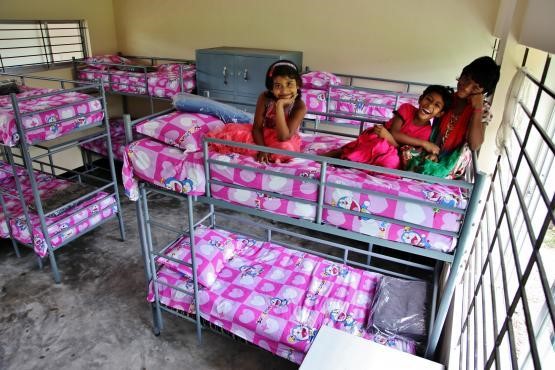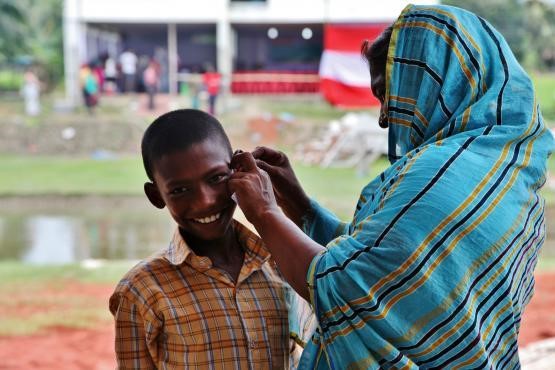

Faridpur city centre, a narrow alleyway draped by a jute curtain separates the normal world from what’s inside. It’s like a portal to another dimension, another world where everything is different. Imagine dark alleyways crowded with men looking to satisfy their libido, and girls and women of all ages standing with heavy makeup making them pale and ghastly as if they died many years ago. No, this is not a brothel from a movie you’ve watched, with all those glitz and glamour, but an eerie network of poorly lit multi-storeyed buildings with small rooms in them. Women stand in front of the doors to greet clients.
This is absolutely not a place where 11-12 year olds would be living and cooking their food when they are not working. Their smaller siblings set out to sleep in small wicker chairs in the alley at night, while their mothers receive clients in the rooms. You cannot call those rooms; they are a shed of just a few square meters with no door to close on them, and definitely no windows. Closely fitting rooms on both side of the long alley with torn drapes, even when its midday, it’s still dark inside. It is crowded and hot; and dogs everywhere, women on their knees bent over on small fires with pots of thin aluminium cooking their food and with paper whisking away the flies and shooing the cats. Dignity? A far cry.
Ette and Smrity were born here in the Faridpur town brothel also known as Rothkhola Brothel – one of the many Government recognised brothels in Bangladesh where about 600 sex workers and their children live and grow up to be a part of the trade. Ette, elder by two years, and Smrity has a brother and their mother Momtaz Begum, this is their family. The children do not know who their fathers are.
Today Ette is eighteen and Smrity sixteen. They live with their mother outside of the brothel and in a shanty built on a land which her mother procured hoping to become a business woman leaving the sex work behind.
It all started from 2002 when Momtaz came to find out about the Self-Help Groups of the sex workers formed by ActionAid and its partner SMS. Momtaz begum and her fellow workers joined the Group and became aware of their rights and the services entitled to citizens of the country. She took trainings on leadership and negotiation, and started to mobilise other sex workers. That time ActionAid was using its Reflect approach to address problems sex workers used to face every day aiming to tackle the issues through advocacy and campaigns. There was a serious trouble with STD’s and drug use (steroids were used to make underage sex workers look older and more attractive to clients).
The initiative of these Self-Help Groups led by leaders like Momtaz Begum changed the scenario of the brothel. Sex workers were not allowed to wear sandals previously; they were not even allowed to be buried in the local cemetery. Their cadavers were thrown to the river. Eventually with the leader’s initiative, the control of the brothel management came to the hands of the sex workers themselves. Gradually they started wearing sandals and were allowed access to the graveyard. Use of steroid drug has been curbed significantly. Then they wanted their children to have a better life.
‘Shaplakuri Child Development Center’ was born. The objective of this centre is to provide children with a safe and enabling environment for their psychological wellbeing and growth, and integration into society.

Initially it catered to the children’s need of a safe home and development, later Shaplakuri centre started realising its objective to sensitise the society in accepting the children as part of them. It was not easy with the intense stigma surrounding the children and their mothers; they were not allowed to be admitted in the mainstream schools. So began continuous awareness and sensitisation campaigns. Today most of the children of the sex workers are going to Government owned public schools; they have more access to the healthcare institutes and are seen as children who also belong to the same community, but yet to go a long way as behavioural change comes through years and years of awareness and sensitisation.
Coming back to Ette and Smrity. They first came to Shaplakuri when Ette was eight and Smrity was six. Today Ette completed her Secondary School Certificate (SSC) and now is studying in the first year of college majoring in Arts. Smrity is a candidate of the ongoing SSC examination. Shaplakuri Child Development centre has gone a long way by the time growing from 12 children in 2003 at a temporary facility to 100 children in 2014 – that too in a permanent serene housing.

Momtaz was continuing her journey towards transforming herself when Ette and Smrity were in Shaplakuri developing themselves. Momtaz was elected to lead the Self-Helf Group ‘Joy Narri Kollan Somity’ became a STAR member under STAR project and a Leader to change lives of the sex workers under the scope of LEADRproject. She played a huge role in ActionAid’s anti-drug Nobojibon Campaign, which eventually helped to eliminate the use of the harmful steroid drugs on the sex workers. Today, Momtaz has left the life of a sex worker and is an elected member of the Home Management Committee of Shaplakuri Child Development Centre.
Momtaz, an empowered women, stands on her own feet earning from her small departmental store. She envisions educating her daughters to University level, preparing them for a good job and getting them married with good partners. She reflects and contemplates that what she achieved in her lifetime and how it turned out for her daughters today, which could have been exactly how her life drowned in the dangerous racket of sex trade.